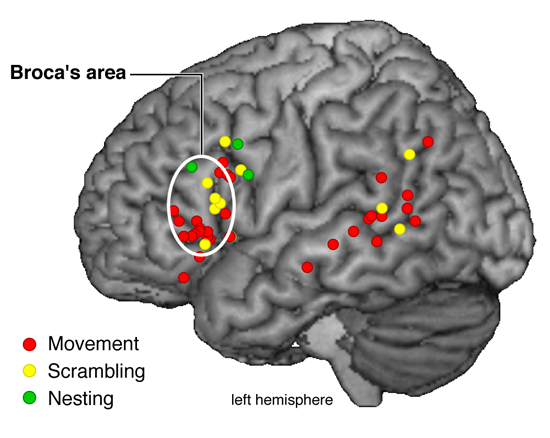The role of Broca’s area in language
Broca’s area consisting of BA 44 and BA 45 (see Fig. 2), has long been known to be involved in language processing (Broca, 1861; Sahin et al., 2009; Zurif, 1980). Its particular function in language comprehension is still a matter of considerable debate (Grodzinsky & Santi, 2008; Hagoort, 2005; 2008; Rogalsky & Hickok, 2011). One view holds that Broca’s region supports verbal working memory (Smith & Jonides, 1999) and that this is why this region shows activation when processing syntactically complex sentences (Rogalsky, Matchin & Hickok, 2008). Another view holds that Broca’s area supports syntactic processes with different subregions being allocated to different aspects of language processing. Here different variants of the syntax-related view can be differentiated: (1) BA 44 as supporting hierarchical syntactic structure building, BA 44/45 as supporting thematic role assignment and BA 45/47 supporting semantic processes (Friederici, 2002), (2) specifying Broca’s area (BA 44/45) as the region supporting the computation of syntactic movement (Grodzinsky, 2000), (3) defining the larger Broca’s region (BA 44/45/47) as a space for the unification of different information types during language processing (Hagoort, 2005). The different views are based on a large number of neuroimaging studies as well as electrophysiological and behavioral studies with healthy individuals and with patients suffering from circumscribed brain lesions. These studies are described in different review articles published over the past decade (Bookheimer, 2002; Friederici, 2002; Grodzinsky, 2000; Grodzinsky & Friederici, 2006; Hagoort, 2005; Rogalsky & Hickok, 2011, Friederici, 2011).
Many studies in different indo-european languages have tried to identify the neural substrate of syntax by investigating the brain basis of processing syntactically complex sentences. These studies often compared brain activation for the processing of noncanonical object-first to canonical subject-first sentences. The positioning of the object-noun phrase before the subject-noun phrase requires a computation that relocates the object-noun phrase from its original position in canonical sentence. Linguistic theories assume different types of computation for different languages dependent on the base structure underlying the canonical sentence, either the computation Movement is assumed, or the computation Scrambling. We will not discuss the linguistic details here since the studies that investigate the processing of object-first versus subject-first sentences all report activation in Broca’s area (for different studies, see Table 4 in Friederici (2011) and Fig. 6). A small set of studies used sentences with nested structures, e.g. center-embedded sentences, to identify the neural basis of syntax processing (see Table 4 in Friederici (2011) and Fig. 6).
To summarize, the processing of syntactically complex sentences in which either the canonical word order is changed or other sentences are embedded requires the involvement of Broca’s area.

Figure 6: Syntax-related activations in the left hemisphere
Maxima of activations for different types of syntactic complexity are color coded: studies investigating Movement (red), Scrambling (yellow) and Nesting (green). The studies reporting these maxima are listed in Table 4 in Friederici (2011). Figure legend is taken from Friederici, 2011 (Physiological Reviews, 91(4), 1357-1392).